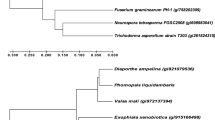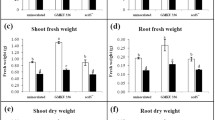Abstract
2-Aminooxyisobutyric acid (AOIB) has a partial structure of aminooxyacetic acid (AOA) in its whole structure, and resembles 2-aminoisobutyric acid (AIB) in their tetrahedral structures. Both AOA and AIB are inhibitors of ethylene biosynthesis; AOA inhibits the action of 1-aminocyclopropane-1-carboxylate (ACC) synthase and AIB inhibits that of ACC oxidase. The present study showed that AOIB inhibited the in vitro activities of both ACC synthase and ACC oxidase, which were synthesized heterologously in E. coli cells from corresponding carnation cDNAs, and the magnitudes of inhibition were similar to those caused by AOA and AIB; AOIB and AOA at 0.1 mM inhibited ACC synthase action by 75%, and AOIB and AIB at 10 mM inhibited ACC oxidase action by 16.3 and 22.5%, respectively. AOIB at 1 mM caused 91.5% reduction of maximum ethylene production rate as compared to the control in cut ‘Excerea’ carnation flowers undergoing senescence, thereby lengthening their vase life to 7 d from 3 d of the control flowers. The inhibition by AOIB was probably caused by its action resembling AOA, but not AIB. AOIB also extended significantly the vase life of cut flowers of ‘Pax’ carnation, and tended to do so in ‘Primero Mango’ carnation. The present findings suggest the potential of AOIB as a new preservative for carnations and other ornamentals in which ethylene plays a key role in the induction of senescence.
Similar content being viewed by others
References
Abeles FB, Morgan PW, Saltveit ME, (1992) Ethylene in Plant Biology, 2nd edn. New York, Academic Press.
Altman SA, Solomos T (1995) Differential respiratory and morphological responses of carnation pulsed or continuously treated with silver thiosulfate. Postharvest Biol Technol 5:331–343
Baker JE, Wang CY, Lieberman M, Hardenburg R (1977) Delayed senescence in carnations by a rhizobitoxine analog and sodium benzoate. HortScience 12:38–39
Bradford MM (1976) A rapid and sensitive method for the quantitation of microgram quantities of protein utilizing the principle of protein-dye binding. Anal Biochem 72:248–254
Bartoli CG, Simontacchi M, Montaldi E, Puntarulo S (1996) Oxidative stress, antioxidant capacity and ethylene production during aging of cut carnation (Dianthus caryophyllus) petals. J Exp Bot 47:596–601
Broun R, Mayak S (1981) Aminooxyacetic acid as an inhibitor of ethylene synthesis and senescence in carnation flowers. Sci Hort 15:277–282
Fujino DW, Reid MS, Yang SF (1980) Effects of aminooxyacetic acid on post-harvest characteristics of canration. Acta Hort 113:59–64
Harada T, Murakoshi Y, Torii Y, Tanase K, Onozaki T, Morita S, Masumura T, Satoh S (2011) Analysis of genomic DNA of DcACS1, a 1-aminocyclopropane-1-carboxylate synthase gene, expressed in senescing petals of carnation (Dianthus caryophyllus) and its orthologous genes in D. superbus var. longicalycinus. Plant Cell Rep 30:519–527
Harada T, Torii Y, Morita S, Masumura T, Satoh S (2010) Differential expression of genes identified by suppression subtractive hybridization in petals of opening carnation flowers. J Exp Bot 61:2345–2354
Kosugi Y, Oyamada N, Satoh S, Yoshioka T, Onodera E, Yamada Y (1997) Inhibition by 1-aminocyclobutane-1-carboxylate of the activity of 1-aminocyclopropane-1-carboxylate oxidase obtained from senescing petals of carnation (Dianthus caryophyllus L.) flowers. Plant Cell Physiol 38:312–318
Kosugi Y, Shibuya K, Tsuruno N, Iwazaki Y, Mochizuki A, Yoshioka T, Hashiba T, Satoh S (2000) Expression of genes responsible for ethylene production and wilting are differently regulated in carnation (Dianthus caryophyllus L.) petals. Plant Sci 158:139–145
Lizada MCC, Yang SF (1979) A simple and sensitive assay for laminocyclopropane-1-carboxylic acid. Anal Biochem 100:142–147
Midoh N, Saijou Y, Matsumoto K, Iwata M (1996) Effects of 1,1- dimethyl-4-(phenylsulfonyl)semicarbazide (DPSS) on carnation flower longevity. Plant Growth Regul 20:195–199
Morita S, Torii Y, Harada T, Kawarada M, Onodera R, Satoh S (2011) Cloning and characterization of a cDNA encoding sucrose synthase associated with flower opening through early senescence in carnation (Dianthus caryophyllus L.). J Japan Soc Hort Sci 80:358–364
Nichols R (1977) Site of ethylene production in the pollinated and unpollinated senscing carnation (Dianthus caryophyllus) inflorescence. Planta 135:155–159
Nijenhuis-de Vries M, Woltering EJ, De Vrije T (1994) Partial characterization of carnation petal 1-aminocyclopropane-lcarboxylate oxidase. J Plant Physiol 144:549–554
Onozaki T, Yamaguchi T (1992) Effect of a-aminoisobutyric acid (AIB) application on the prolongation of the vase life of cut carnation (Dianthus caryophyllus) flowers. Bull Natl Res Instit Veg Orn Plants Tea Series A No. 5:69–79
Reid MS, Paul JL, Farhoomand MB, Kofranek AM, Staby GL (1980) Pulse treatment with silver thiosulfate complex extend the vase life of cut carnations. J Amer Soc Hort Sci 105:25–27
Satoh S, Esashi Y (1980) a-Aminoisobutyric acid: A probable competitive inhibitor of conversion of 1-aminocyclopropane-1- carboxylic acid to ethylene. Plant Cell Physiol 21:939–949
Satoh S, Esashi Y (1983) a-Aminoisobutyric acid, propyl gallate and cobalt ion and the mode of inhibition of ethylene production by cotyledonary segments of cocklebur seeds. Physiol Plant 57:521–526
Satoh S, Suetome N, Namura S, Kuwabara H (2008) Prolonged vase life of Dianthus superbus by 2-aminoisobutyric acid and cispropenylboric acid. Floric Ornam Biotech 2:5–8
Satoh S, Yoshioka T, Kosugi Y (1995) Characteristics of 1- aminocyclopropane-1-carboxylate synthase isolated from senescing carnation flower petals. Acta Hort 394:297–304
Serrano M, Romojar F, Casas JL, Del Rio JA, Acosta M (1990) Action and mechanism of a-aminoisobutyric acid as a retardant of cut carnation senescence. Sci Hort 44:127–134
Sisler EC, Dupille E, Serek M (1996) Effects of 1-methylcyclopropane and methylenecyclopropane on ethylene binding and ethylene action on cut carantions. In, Smith AR, Moshkov IE, Novikova GV, Hall MA edrs. ‘Plant Hormone Signal Perception and Transduction’, pp 127–134, Kluwer Academic Publishers, Amsetrdam.
ten Have A, Woltering EJ (1997) Ethylene biosynthetic genes are differentially expressed during carnation (Dianthus caryophyllus L.) flower senescence. Plant Mol Biol 34:89–97
Veen H (1979) Effects of silver on ethylene synthesis and action on cut carnations. Planta 145:467–470
Wawrzynczak A, Goszyczynska DM (2003) Effects of ethylene inhibitors on longevity of carnations (Dianthus caryophyllus L.) and ethylene production by flowers. J Fruit Orn Plant Res 11:89–98
Woodson WR, Park KY, Drory A, Larsen PB, Wang H (1992) Expression of ethylene biosynthesis pathway transcripts in senescing carnation flowers. Plant Physiol 99:526–532
Yang SF, Hoffman NE (1984) Ethylene biosynthesis and its regulation in higher plants. Ann Rev Plant Physiol 35:155–189
Yangkhamman P, Fukai S, Ichimura K (2005) Ethylene production and vase life of cut carnation flowers under high temperature conditions. J Japan Soc Hort Sci 74:337–341
Yu YB, Adams DO, Yang SF (1979) 1-Aminocyclopropane-1- carboxylate synthase, a key enzyme in ethylene biosynthesis. Arch Biochem Biophys 198:280–286
Author information
Authors and Affiliations
Corresponding author
Rights and permissions
About this article
Cite this article
Kosugi, Y., Matsuoka, A., Higashi, A. et al. 2-Aminooxyisobutyric acid inhibits the in vitro activities of both 1-Aminocyclopropane-1-carboxylate (ACC) synthase and ACC oxidase in ethylene biosynthetic pathway and prolongs vase life of cut carnation flowers. J. Plant Biol. 57, 218–224 (2014). https://doi.org/10.1007/s12374-014-0180-4
Received:
Accepted:
Published:
Issue Date:
DOI: https://doi.org/10.1007/s12374-014-0180-4




